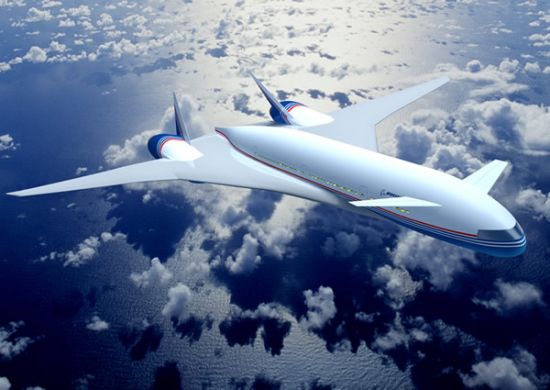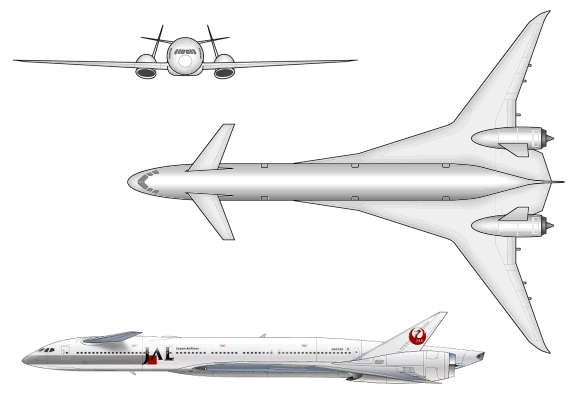|
||||||||||
|
|
||||||||||
|
||||||||||
|
|
||||||||||
 - -
|
|

|
Boeing Sonic Cruiser Long-Range Jetliner |
|
DESCRIPTION:
Following a strategic review of future markets, Boeing cancelled further development of the 747X intended to compete with the Airbus A380 in favor of a radically new concept dubbed the Sonic Cruiser. In contrast to the Airbus decision to develop a very large aircraft, Boeing believed a much stronger market existed in serving widely separated city pairs at speeds 15% to 20% faster than is possible with current airliners. Boeing hoped to meet this need with an aircraft designed to fly just under the speed of sound, thereby avoiding the noise polution issues associated with sonic booms. While such an aircraft has long been dreamt of, many complex technical challenges need to be overcome before economical flight in the Mach 0.95 region becomes a reality. The most significant of these challenges are minimizing the increase in transonic drag that occurs past Mach 0.85 and developing very efficient engines to minimize the amount of fuel required. Unfortunately, there is little evidence to suggest current technologies can satisfy these requirements, but it was conceivable that Boeing could overcome these limitations to meet the specified range goals of 9,000 to 10,000 nm (16,670 to 18,530 km). The Sonic Cruiser design was about the size of the 767 with seating for approximately 250 passengers. The airframe featured an aft-mounted double-delta wing with very large, thick root extensions to provide significant fuel volume. Canard surfaces mounted near the nose would provide pitch control. This arrangement had the advantage of providing a large, constant diameter fuselage in between the canards and wing to maximize the size of the passenger compartment and provide space for fuselage inserts in future stretch models. Engine pods installed along the wing trailing edge were partially blended into the wings to reduce drag. Plans called for fitting engines derived from those used on the 777. Though the Sonic Cruiser created quite a stir in the aviation community, both the airlines and Boeing became increasingly less enthusiastic as the post-September 11 recession hit the airline industry. The sudden drop in air travel coupled with high development costs and Boeing's failure to convince airlines that shorter travel times were desirable quickly took their toll on the fledgling concept. As a result, Boeing officially shelved the high-speed plane on 20 December 2002. Instead, the company refocused its efforts on a conventional cousin of the Sonic Cruiser. This design, referred to as the first phase of Project Yellowstone or the 7E7 Dreamliner, makes use of many of the advanced technologies proposed for the Sonic Cruiser to create a "super-efficient" airliner with significantly lower operating costs than today's aircraft. The 7E7 was later rechristened as the 787.
Last modified 08 September 2010
|
|
| HISTORY: | |
| First Flight | never flown |
|
Service Entry
|
did not enter service
|
| CREW: |
two flight crew: pilot, co-pilot
|
| PASSENGERS: |
200 to 250 in three classes
|
|
ESTIMATED COST:
|
unknown
|
| AIRFOIL SECTIONS: | |
| Wing Root | unknown |
|
Wing Tip
|
unknown
|
| DIMENSIONS: | |
| Length | unknown |
| Wingspan | unknown |
| Height | unknown |
| Wing Area | unknown |
|
Canard Area
|
unknown
|
| WEIGHTS: | |
| Empty | unknown |
| Normal Takeoff | unknown |
| Max Takeoff | unknown |
| Fuel Capacity |
internal: unknown external: not applicable |
|
Max Payload
|
unknown
|
| PROPULSION: | |
| Powerplant | two turbofans based on the Pratt & Whitney PW4000, Rolls-Royce Trent, or General Electric GE90 |
| Thrust |
unknown
|
| PERFORMANCE: | |
| Max Level Speed |
at altitude: unknown at sea level: unknown cruise speed: 625 to 650 mph (1,010 to 1,040 km/h) at 40,000 ft (12,205 m), Mach 0.95 to 0.98 |
| Initial Climb Rate | unknown |
| Service Ceiling | 45,000 ft (13,730 m) |
| Range |
6,000 to 7,500 nm (11,120 to 13,900 km) planned for early models 9,000 to 10,000 nm (16,670 to 18,530 km) possible for later models |
| g-Limits |
unknown
|
| KNOWN VARIANTS: | |
| Sonic Cruiser |
Only designation given for this aircraft concept carrying around 250 passengers over ranges up to 9,000 nm
(16,670 km) in 2 or 3 hours
|
|
3-VIEW SCHEMATIC:

|
|
SOURCES:
|
|


|
Aircraft | Design | Ask Us | Shop | Search |

|
|
| About Us | Contact Us | Copyright © 1997-2023 | |||
|
|
|||